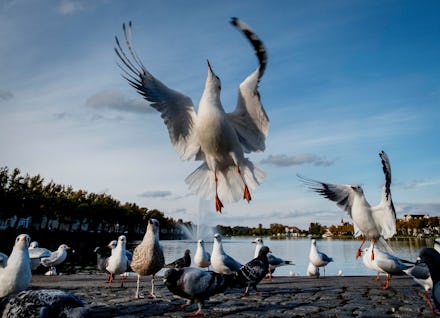America's birds are at risk due to climate change — and that's bad news for humans

If we don't manage to get our act together and address human-caused climate change, we'll likely end up making the earth uninhabitable for ourselves — but birds will feel that pain long before we will. A new report from the National Audubon Society suggests that two-thirds of North American birds are at an increased risk of extinction due to the global rise in temperatures caused by climate change. That's important news for the rest of us because when things get rough for our winged friends, equally bad outcomes tend to follow for us bound to the ground.
To determine the challenges facing birds between now and 2100, scientists examined 140 million bird records that apply to 604 North American bird species. That includes observational data from field biologists and bird watchers recorded in the United States, Canada and Mexico. The findings are pretty dire if we don't make some drastic changes. Using models to project potential risks for birds based on different levels of possible temperature increases over the remainder of the century, the National Audubon Society projected that 389 bird species will be moderately or highly vulnerable to extinction. Essentially every arctic bird species will sit on the brink of no return, as will 86 percent of western forest birds and 78 percent of water birds. Iconic state birds like Minnesota's loon, New Jersey's goldfinch and California's quail will also face crisis according to the projections.
These projections assume that we surpass a rise in global temperatures of three degrees Celsius, which is basically what we are on track for, according to Climate Action Tracker, if additional changes aren't made by our governments to end reliance on fossil fuels and limit the amount of carbon emissions that we put into the atmosphere every year.
Obviously, if swift action is taken and we are able to limit the global temperature increase, the threat posed to our feathered friends would be lessened. If, for instance, we keep warming to 1.5 degrees Celsius — the goal established by the Paris Climate Agreement — then the vast majority of birds would be saved from potential extinction events. The National Audubon Society projects the more restrained rise in temperatures would allow 76 percent of bird species in North America to have a greater chance of survival and 150 species would no longer be considered vulnerable to climate-caused extinction.
The National Audubon Society released its first findings on the potential impact of climate change on North American birds back in 2014. At the time, it suggested that nearly half of the bird species on the continent would be sensitive to rising temperatures. Five years later, armed with more data and following record amounts of carbon emissions being pumped into the atmosphere, things appear even more dire than they did just half a decade earlier. Now the organization projects that, even if they aren't pushed to the point of extinction, 97 percent of birds in North America will deal with some effects from climate change.
Birds have already had a pretty rough go of things over the course of the last few decades. A recent study published in Science suggested that, between 1970 and 2019, there has been a 29 percent decline in the number of birds in North America. That represents a loss of nearly three billion total birds across the U.S., Canada and Mexico. There are many contributing factors to the rapid decline, ranging from pesticides that kill insects that are a food source for some bird species to feral cats killing billions of birds each year to the nearly one billion birds that die annually running into windows. But it should not be lost on us that the rapid decline started around the same time that our global temperature started rising at an abnormal rate. Climate change already plays a role in the viability of many bird species and its effects will only be exacerbated as temperatures continue to rise.
Climate change will unquestionably impact humans directly, but we should care pretty deeply about preserving the lives of birds. They are bellwethers for climate change, and their viability speaks directly to our own. We also really, really need the creatures to stick around. Simply by being members of our ecosystem, birds help to control the spread of pests and disease-carrying insects that could harm plants, other animals and humans. Crops like grapes and coffee are heavily protected by birds, who eliminate bug-based threats. They are also key contributors when it comes to pollinating plants and spreading seeds. When we lose birds, we also lose other species; when the birds that pollinated Hawaiian bellflowers disappeared, the plants themselves went extinct in short order.
Put simply, we need birds. They are an invaluable part of our overall ecosystem and the potential extinction facing them could result in a considerable amount of unexpected fallout. Limiting our carbon emissions and keeping global temperature rises below 1.5 degrees Celsius over the next 80 years is imperative not just to humans but to birds as well. When we stop seeing birds, you can bet that our own extinction might not be far behind.